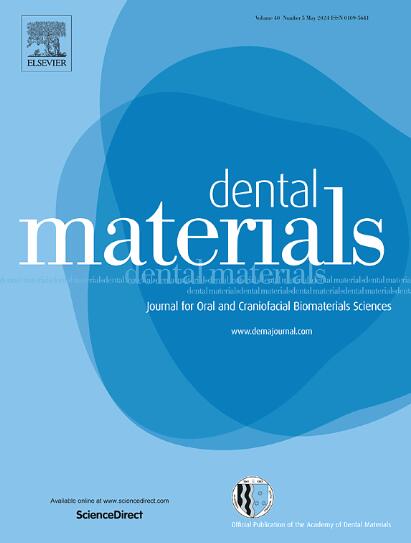Bond strength of a 3-step total-etch bonding system to dentine – An improved approach
IF 4.6
1区 医学
Q1 DENTISTRY, ORAL SURGERY & MEDICINE
引用次数: 0
Abstract
Background
Generally, the bonding of one material to another is important for function, and especially in so-called ‘adhesive dentistry’. However, there are concerns about the clinical relevance and the discriminatory power of currently employed tests of bond strength.
Objective
Develop and validate a test protocol based on 4-point bending that may be used to examine the bonding of various dental materials to a range of substrates. The bonding of a resin-based composite (RBC) to dentine is taken as an example.
Methods
Slices of dentine ‘coupons’ (5.0 × 2.0 × ∼4–6 mm3) from extracted molars were prepared using a diamond saw under running water. Pairs of RBC bars (5.0 × 2.0 × ∼24 mm3) (Z250) were bonded symmetrically either side of a dentine coupon using all combinations of the following treatments: E: acid-etched (Scotchbond Universal Etchant), P: primer (Adper Scotchbond Multipurpose Adhesive); A: adhesive (Adper Scotchbond Multipurpose Primer) (all 3 M) as well as N: no treatment. Following retrieval from the mould, test pieces were immediately subjected to 4-point bending at 23 °C, cross-head speed 0.5 mm/min, until fracture. Three-way analysis of variance on log(flexural strength): etch × primer × adhesive, was applied. Scanning electron microscopy (SEM) was used to examine fracture surfaces and identify failure origins.
Results
Flexural strengths in MPa: N: 1.38 ± 0.56; P: 9.82 ± 0.89; A: 5.12 ± 0.73; E: 9.39 ± 1.78; E + P: 21.03 ± 2.63; E + A: 12.80 ± 1.53; P + A: 17.16 ± 3.03; E + P + A: 20.84 ± 3.93. The treatment main effects (all, p < 10−12) were not additive, there being significant two-way (p < 10−5) and three-way (p = 0.037) interactions. There was no significant difference between E + P + A and E + P (p = 0.86).
Conclusion
With good reproducibility (low scatter), discriminatory power (clear treatment effects), economy with regard to substrates, the method has the potential to be adaptable to many systems.
求助全文
约1分钟内获得全文
求助全文
来源期刊

Dental Materials
工程技术-材料科学:生物材料
CiteScore
9.80
自引率
10.00%
发文量
290
审稿时长
67 days
期刊介绍:
Dental Materials publishes original research, review articles, and short communications.
Academy of Dental Materials members click here to register for free access to Dental Materials online.
The principal aim of Dental Materials is to promote rapid communication of scientific information between academia, industry, and the dental practitioner. Original Manuscripts on clinical and laboratory research of basic and applied character which focus on the properties or performance of dental materials or the reaction of host tissues to materials are given priority publication. Other acceptable topics include application technology in clinical dentistry and dental laboratory technology.
Comprehensive reviews and editorial commentaries on pertinent subjects will be considered.
 求助内容:
求助内容: 应助结果提醒方式:
应助结果提醒方式:


